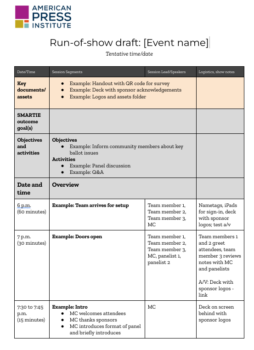How a ‘run of show’ document can make your journalism event a success
Caitlin Dewey, for API’s Better News,
(Rudy Dong / Unsplash)
This handy, one-stop reference helps staff get organized and stay in sync for live events.This is a series on Better News to a) showcase innovative/experimental ideas that emerge from the Knight-Lenfest Newsroom Initiative and b) share replicable tactics that benefit the news industry as a whole.
This piece features tips from Samantha Melbourneweaver, the managing editor for digital audience growth and engagement at NPR and the former assistant managing editor for audience at the Los Angeles Times, based on material she taught in the American Press Institute’s Live Events Sprint for Table Stakes Alumni in 2024.
More from this program:
- A run of show template
- 6 live journalism event ideas you can replicate in your community
- A workbook to take you from journalism event idea to execution
- How to pick the right venue for your journalism event
- A spreadsheet that will help you organize research about your possible venues
- An event proposal document to help you get started on your next journalism event
- Leveraging partnerships and sponsorships for journalism events
- Sponsor pitch deck template and accompanying guide
- A checklist for marketing your live journalism events
- Using events to supercharge your election coverage
Live events can be a powerful platform for news organizations to showcase their journalism, engage with their audiences and potentially drive new revenue. But the logistics of organizing and executing a successful event can seem daunting, especially for outlets that haven’t hosted many events before.
That’s where the “run of show” document comes in — a handy, one-stop reference that helps staff get organized before an event and stay in sync through its close. The model comes from TV, where run of show docs — also called rundowns — have been used for years to coordinate sprawling, multifunctional teams and keep programs on schedule.

Run of show docs can take different forms, depending on the scale and needs of the particular event. But ideally, said Samantha Melbourneweaver, the managing editor for digital audience growth and engagement at NPR, a run of show doc should contain enough information that one staffer could sub in for another if anyone has to drop out at the last minute.
“I know it sounds stressful,” said Melbourneweaver, who in her previous role as the assistant managing editor for audience at the Los Angeles Times used run of show documents to execute events ranging from basketball game watch-alongs to book lectures. “But remember, this is the one document that everyone gets. This is to keep you from having a bunch of email threads and a bunch of texts that all say different things to different people …
“And this is so, if someone comes down with a cold and can’t be the emcee, at least there’s the rough outline of a script here so that someone new can jump in and solve that problem.”
Before you draft your run of show doc
Drafting your run of show document should start early — soon after you begin planning the event itself. Melbourneweaver challenges event teams to let the “5Ws” of events guide the early planning process.
The “5Ws” help build out a larger vision for the event:
- Who is this for? (What do they need? How do they receive information best?)
- What do we want to say? (What is your expertise? What do you want attendees to take away from the event?)
- When should this happen? (How long do you need to attract sponsors or find a good venue?)
- Where will this be held? (How many people do you expect? What’s the venue’s schedule?)
- Why is this an event, as opposed to something else? (Does the topic foster deeper community connections or lend itself to behind-the-scenes access?)
- How much will it cost? (And how will you fund it — paid ticketing? Donations? Sponsorships?)
API has created an event proposal template to help organizers think through some of these questions. Once they have their answers in place, they’re ready to draft a run of show document.
Drafting your run of show doc
Run of show docs can take many forms, according to the size and complexity of the event. Small, simple and routine events might require only brief rundowns. But more elaborate productions — such as festivals, film screenings or large panels — might necessitate run of show docs as long as eight to 10 pages. A basic template from API is available here.
At minimum, a run of show doc should include:
- The name, time and date of the event, including setup and teardown times
- The event’s objectives
- Contact information (name, email address and cell phone number) for everyone involved, including venue/vendor staff and external talent
- An item-by-item rundown of the show, with stage directions and time limits
- Links to related documents and assets, such as multimedia presentations, polls, sponsor messages and ticketing pages
- Additional logistical details
- Speaker names and pronunciations (checked beforehand, if needed)
- Technical requirements, such as audio-visual equipment or Wi-fi access
- Staff roles and responsibilities
- Transitions between event segments, such as the verbal cue the event host will use to signal the beginning or end of a Q&A session
Generally speaking, Melbourneweaver said, events teams should err on the side of detail, not conciseness. She uses the following rule of thumb: If it’s an event issue or detail that you would email two or more people about, then it should go in the run of show.
Drafting a run of show can also help news organizations identify early staffing or resource gaps: Who’s going to set up the tables at the entrance? Who’s going to advance the slides in a presentation?
“It is so much better to overstuff it with extra information than to leave it too sparse,” Melbourneweaver said. “You can’t add too much detail to it — genuinely, you can’t.”
Run of show docs in action
Everyone on the event team should have edit access to run of show documents, even in the drafting stages, Melbourneweaver said. That allows individuals to make notes to themselves, familiarize themselves with the entire schedule and prepare to jump in if something doesn’t go as planned.
There’s no need for a full-on dress rehearsal, Melbourneweaver added, but event organizers should meet one-on-one with event participants to briefly go over the run of show. In fact, she recommends approaching external talent only after a run of show has been drafted, in order to help them understand their exact role and avoid any confusion or grandstanding on the day of the event.
When that day arrives, Melbourneweaver also recommends one last meeting with staff to go over the timing and logistics of the event and make last-minute adjustments to the run of show, as needed.
“It’s like synchronizing your watches in a spy movie,” she said. “Hopefully, you have a printed-out run of show and everyone … makes the same changes.”
The run of show is not a script. While it may include some scripted information (such as an MC’s opening remarks or a list of questions for panelists), it’s intended chiefly to guide your event’s logistics and timing. The conversational elements will be more organic.
“Remember that the best things have a live feel,” Melbourneweaver said. “You want to match the beats of the run of show … but if [participants] want to go rogue a little bit and add their own personality to it, that’s great. As long as they stick to the timing and the general structure of the run of show, then you can be on time and actually deliver what you need to deliver” at the event.